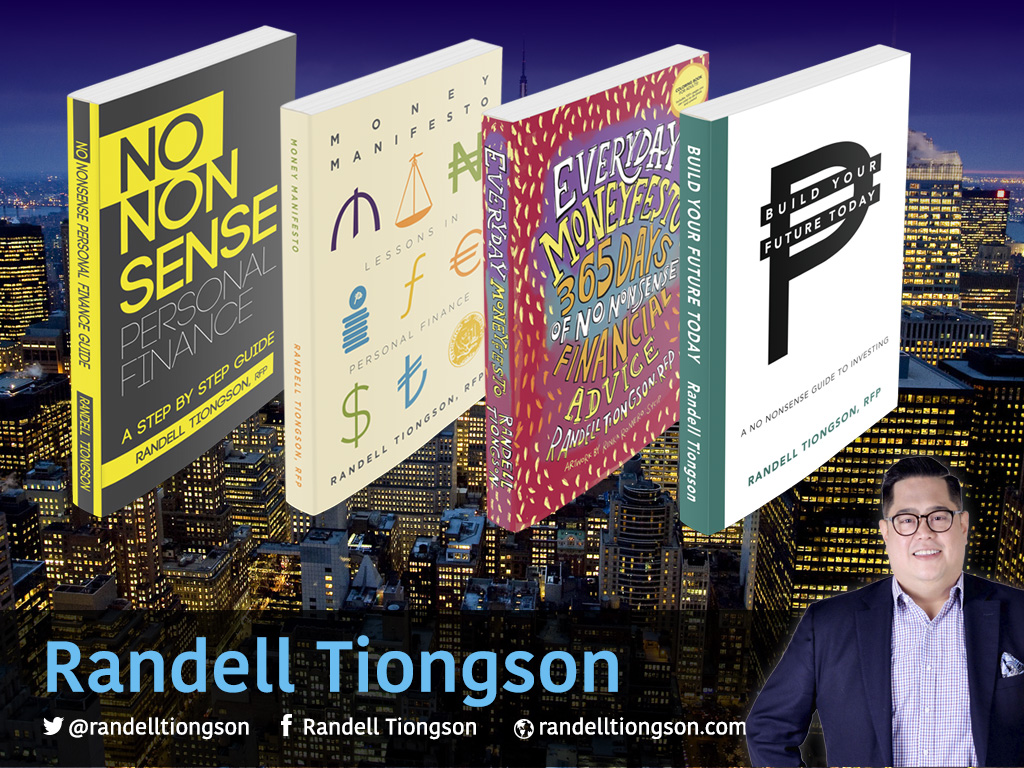Why do Pinoys not invest?
By Randell Tiongson on April 27th, 2017
I recently saw an infogram stating that only 8% of Filipinos have some form of an investment like stocks, mutual funds, UITF or insurance. Although there has been some gains in the number of Filipinos who have begun investing, we are still way behind many other nations with regard to investing by its citizens.
The stock market, though volatile, has proven itself as a good way to build wealth for those who are investing in it. Investment instruments like mutual funds and UITF have made investing easier, more accessible and even more convenient to the Filipinos and the number of those invested remains to be dismal.

Why we do not invest
The most obvious reason for the low investing numbers is the low income of many of our citizens; the lack of spare cash makes investing impossible. What about those who are earning better or those who belong to the middle class? Studies shows that there are about 25.2% of the Filipino families belong to the ‘middle’ class and 0.1% belongs to the ‘upper’ class or a total of 25.3% and yet there are only 8% who invest. It seems safe to assume that about 16% of us who can invest don’t. So why are we not too keen of investing then? Most common reasons would be fear, ignorance, difficulty and inertia.
I asked my financial advocate friends on why they think Pinoys do not like to invest and these are what they said:
“Attitude and behavior. Delayed gratification isn’t easy for Filipinos. Most of us live ‘in the now rather than preparing for the future.” – Rex Mendoza, leading investment expert and President of Rampver Financials
“Not educated enough in various investment tools – such as stocks, bonds, currencies and funds; scared to lose their hard earned salary to investments they’re not aware of.” – Rico Hizon, International News Anchor at BBC
“Lack of financial literacy and could not figure out their own context.” – Francis J. Kong, leading inspirational guru and award winning-author
“I think one reason Filipinos fail to invest is simply because of lack of awareness or lack of knowledge on investment options. Some simply haven’t heard of mutual funds or UITFs and other vehicles, while others may be aware of them but do not know much about them – how they work, how to buy them, etc, or even have the misconception that you need a lot of money to be able to invest.” – Riza Mantaring, CEO of Sun Life Financial
“Investing is not intuitive for us; it is not taught at home.” – Marvin Germo, leading stock market advocate
“No clear and defined goal: they have not yet identified which particular amount and goal they should earmark that investment for.” – Rienzie Biolena, finance and investment educator
“Small goals. Without big goals, the motivation to invest is not there.” – Carl Dy, property investing expert
“Knowledge, access and the right mindset about ‘now vs. later’.” – Marvin Fausto, fund manager and investment expert
“Pinoys do not prioritize investing because they prioritize wants over needs, have too much debt, too many dependents and uncontrolled spending.” – Chinkee Tan, wealth coach and media personality
“People fail to invest in their future because they want to enjoy their money even when it is still small. Most cannot wait for the day when they have grown the little they have so that they can enjoy more.” – Dodong Cacanando, business speaker and best-selling author
“Media and advertising focuses too much on FMCGs (fast moving consumer goods) and beauty products, unlike places like Singapore and the UK where there is so much awareness and advertising related to investing in financial intermediaries like pension funds, insurance companies and mutual funds.” Andrew Wolff, celebrity host and entrepreneur
In addition, I also posted in Facebook and Twitter this question: “in your opinion, what is the leading reasons why there are very few Filipinos who invest, aside from having no extra funds?”
Here are some of the their answers:
- Afraid to lose money
- Fear of scams
- Instant gratification
- Poor cash flow management
- Too much debt
- Current education system
- Demonization of money
- Dependence to family members
- No knowledge
- Investing is only for the rich
- They only want guaranteed returns
- Not really thinking about the future; poor planning
- Not in our culture
- Wrong priorities
- Not knowing where and how to invest
- Care-free attitude
- Lack of patience
- Family upbringing
- Lack of focus and discipline
- Wrong mindset
There are many reasons why we do not invest, some may even be valid ones. However, there are more reasons why we SHOULD invest. We need to build and prepare for our future and investing is paramount in that very important facet of our lives.
Financial education is important for all of us and should be the first step as we begin to invest so we can build our future today.
I am excited to announce that I have a new book on practical investing and it is titled “Build Your Future Today: a No Nonsense Guide to Investing“.

Best investments for retirement
By Randell Tiongson on November 3rd, 2016
Question: Hi Randell! Good morning! After browsing the net for Filipino personal finance tips, I learned about you. And after reading your articles, I’m very much driven to start investing. I’m already in my 30s and wishing I started earlier. But I can’t dwell on that anymore, so I’m ready to start now. As you keep saying, “the best time to invest was Tuesday, the next best time to invest is today.” With that, I know I should start investing, but where? With the multiple investments available, I don’t know where to start. It’d be great if you could help me on this. Thank you very much and God bless! —Carlo via Facebook

Answer: Hi Carlo! Thank you for messaging me. I’m sharing your query here in my column because I’m sure many Filipinos can relate to your situation. Many hold off saving for retirement because of the mentality that there are still many years left to save, but as you learned, the best time to invest was Tuesday, and the next best time is now. Don’t wait until you’re nearing retirement because investments are meant to be long-term. With that in mind, now we know that we should go for investment vehicles that are more for the long term. So what are these investments?
Property
Real estate is probably the favorite investment of Filipinos. While less than 1 percent of the Philippine population invests in stocks, bonds, and mutual funds, 7 in 10 Filipinos own their homes, according to the Bangko Sentral ng Pilipinas’ (BSP) 2012 Consumer Finance Survey.
Real estate is an advisable investment for retirement because the value of property appreciates through the years. Real estate property isn’t like a time deposit which gives you interest after a year (or less). You won’t make much by selling your property just after 6 or 12 months.
Stocks
Another investment vehicle is stock investing. Stocks are advisable for the long-term because they are risky. This means that the prices of stocks go up and down over a set time period, and you can lose money. One way to decrease your risk and avoid losses is to hold your stocks for the long-term, which makes stocks perfect for retirement. I recommend people to keep their stocks for a minimum of 10 years.
Seeing as you are in your 30s, you have about another 25 more years before you reach retirement age. That’s 20 years more than my suggested 10 years to spread your risk.
Pooled funds
I purposely put ‘pooled funds’ after ‘stocks’ because they are closely related. If you want to buy stocks of SM, Ayala, or Jollibee, you would have to buy them individually through a stock broker or your online trading platform. With pooled funds, be it a mutual fund or a UITF, you get a group of stocks in one basket or fund. The pooled fund can have SM, Ayala, and Jollibee stocks, depending which equities the fund manager buys. The fund manager does the investing for you.
He picks what stocks go into the pooled fund; all you have to do is make an investment deposit and keep track of your investments once or twice a year. It’s also important to know that there are different kinds of pooled funds, there are funds consisted entirely of stocks, others of bonds, while some funds offer a combination of different securities. For the purpose of retirement, and for Carlo who has about 25 years until retirement, a stock or equity-based pooled fund is best for a retirement which is still far away.
With three investments to choose from, you have a clearer idea of where to put your money for retirement. Now the only thing that’s left is to head to the bank (for UITF pooled funds) or a brokerage firm (for stocks and mutual funds) to fill out your application and open an investment account.
Variable Universal Life Insurance
A VUL is very similar to pooled funds but it has a life insurance component and therefore, there is cost of insurance imbedded in the policy. However, if you are in need of financial protection and also want to prepare for retirement at the same time, a VUL will come in handy.
With four investments to choose from, you have a clearer idea of where to put your money for retirement. Now the only thing that’s left is to head to the bank (for UITF pooled funds), a brokerage firm (for stocks) or a financial adviser (for mutual funds and VUL) to fill out your application and open an investment account.
Always remember that there is no such thing as a best investment. Remember to do your assignment well and do not forget to diversify and the key to a comfortable retirement is to start preparing early.
Read my books for practical finance and investments! Email [email protected] or visit National Bookstores to get my books!

Investments for Retirement
By Randell Tiongson on July 25th, 2016

Question: Hi Randell! Good morning! After browsing the net for Filipino personal finance tips, I learned about you. And after reading your articles, I’m very much driven to start investing. I’m already in my 30s and wishing I started earlier. But I can’t dwell on that anymore, so I’m ready to start now. As you keep saying, “the best time to invest was Tuesday, the next best time to invest is today.” With that, I know I should start investing, but where? With the multiple investments available, I don’t know where to start. It’d be great if you could help me on this. Thank you very much and God bless! — Carlo via Facebook
Answer: Hi Carlo! Thank you for messaging me. I’m sharing your query here in my column because I’m sure many Filipinos can relate to your situation. Many hold off saving for retirement because of the mentality that there are still many years left to save, but as you learned, the best time to invest was Tuesday, and the next best time is now. Don’t wait until you’re nearing retirement because investments are meant to be long-term. With that in mind, now we know that we should go for investment vehicles that are more for the long term. So what are these investments?
Property
Real estate is probably the favorite investment of Filipinos. While less than 1 percent of the Philippine population invests in stocks, bonds, and mutual funds, 7 in 10 Filipinos own their homes, according to the Bangko Sentral ng Pilipinas’ (BSP) 2012 Consumer Finance Survey.
Real estate is an advisable investment for retirement because the value of property appreciates through the years. Real estate property isn’t like a time deposit which gives you interest after a year (or less). You won’t make much by selling your property just after 6 or 12 months.
Stocks
Another investment vehicle is stock investing. Stocks are advisable for the long-term because they are risky. This means that the prices of stocks go up and down over a set time period, and you can lose money. One way to decrease your risk and avoid losses is to hold your stocks for the long-term, which makes stocks perfect for retirement. I recommend people to keep their stocks for a minimum of 10 years.
Seeing as you are in your 30s, you have about another 25 more years before you reach retirement age. That’s 20 years more than my suggested 10 years to spread your risk.
Pooled funds
I purposely put ‘pooled funds’ after ‘stocks’ because they are closely related. If you want to buy stocks of SM, Ayala, or Jollibee, you would have to buy them individually through a stock broker or your online trading platform. With pooled funds, be it a mutual fund or a UITF, you get a group of stocks in one basket or fund. The pooled fund can have SM, Ayala, and Jollibee stocks, depending which equities the fund manager buys. The fund manager does the investing for you. He picks what stocks go into the pooled fund; all you have to do is make an investment deposit and keep track of your investments once or twice a year. It’s also important to know that there are different kinds of pooled funds, there are funds consisted entirely of stocks, others of bonds, while some funds offer a combination of different securities. For the purpose of retirement, and for Carlo who has about 25 years until retirement, a stock or equity-based pooled fund is best for a retirement which is still far away.
With three investments to choose from, you have a clearer idea of where to put your money for retirement. Now the only thing that’s left is to head to the bank (for UITF pooled funds) or a brokerage firm (for stocks and mutual funds) to fill out your application and open an investment account.
However, there is no such thing as a so you will need to diversify.
Want a copy of my books? You can order directly from us. Just e-mail [email protected]








